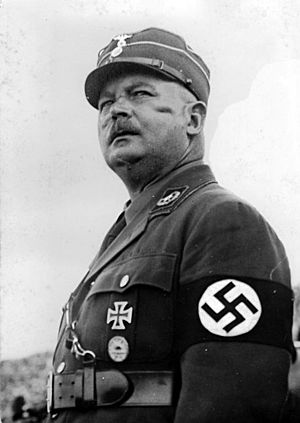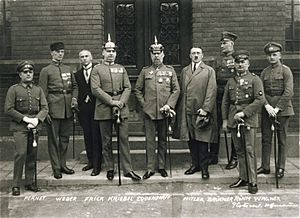Ernst Röhm facts for kids
Quick facts for kids
Ernst Röhm
|
|
|---|---|
 |
|
| Born | November 28, 1887 Munich, German Empire
|
| Died | July 2, 1934 (age 46) Stadelheim Prison, Munich, Germany
|
| Cause of death | Shot |
| Nationality | German |
| Occupation | Chief of Staff, Sturmabteilung, (SA) |
| Parent(s) | Julius Röhm and Emilie Röhm |
Ernst Julius Röhm (born November 28, 1887, in Munich – died July 1, 1934, in Munich) was an important leader in Germany. He helped start a group called the Sturmabteilung, also known as the Stormtroopers.
He was also a member of the German parliament and served as a minister from 1933 to 1934. Later, Adolf Hitler became concerned about Röhm's growing power. Hitler then ordered Röhm's arrest and death. Röhm died during an event known as the Night of the Long Knives in 1934.
During the First World War, Röhm was an officer. He received an award called the Iron Cross First Class for his bravery.
Contents
Early Life
Ernst Röhm was born in Munich on November 28, 1887. He was the third child of Julius Röhm, who was a chief train inspector, and his wife, Emilie Röhm. He had an older brother and an older sister.
In 1906, after finishing his school exams in Munich, Röhm joined the Bavarian army. He started as a junior officer. Two years later, he became a Lieutenant.
First World War Service
In 1914, when the First World War began, Röhm was an adjutant, which is an officer who helps a senior commander. He fought on the Western Front. He was hurt three times during the war.
He received the Iron Cross First Class, a special award for soldiers. In 1914, he was badly injured and lost a part of his nose bone. He also worked for the Bavarian government in the War Department. In 1918, he was promoted to the rank of captain.
After the First World War, Röhm joined a group called the Freikorps (Free Corps). He wanted to fight against the Communists in Munich. With this group, he helped fight against the Bavarian Soviet Republic. In July 1919, the Freikorps became part of the German army, known as the Reichswehr.
Joining the Nazi Party
In 1919, Röhm joined the German Workers' Party. This party later became known as the Nazi Party. One year later, he became a member of the German Nazi Party. He was given the membership number 623.
Röhm helped Hitler connect with important people in Bavaria, including politicians and business owners. Two years later, Röhm and Hitler started the Sturmabteilung (SA). This group was made up of many men from the Freikorps. It was a special group of supporters for the German Nazi Party. Hitler made Röhm the leader of the SA.
Röhm took part in the Beer Hall Putsch in 1923. This was an attempt by the Nazi Party to take over the government, but it did not succeed. Röhm was arrested because of this event. He was in prison for five months and lost his job in the army. After the court trial, both the Nazi Party and the Sturmabteilung were temporarily not allowed to operate.
In 1924, Röhm helped start a new group called the Frontbann. This group was similar to the Sturmabteilung. After a disagreement with Adolf Hitler, Röhm stepped down as leader of the SA. He said he was a soldier, not a politician. Between 1928 and 1930, he worked for the military in Bolivia as an advisor.
Leader of the Sturmabteilung

On November 1, 1930, Röhm returned to Germany and rejoined the Nazi Party. In January 1931, Adolf Hitler put Röhm in charge of the Sturmabteilung again. In just over a year, he made the group much larger. It grew from 70,000 members to 170,000 members.
In April 1932, the German leader, Chancellor Heinrich Brüning, banned the SA again. However, Franz von Papen, who became chancellor after Brüning, removed the ban in June. In 1933, Ernst Röhm became a Reichsminister, which was a minister in the German parliament. By 1934, the SA had more than 4,500,000 members.
The SA's power grew very quickly. Because of this, Adolf Hitler and another group called the Schutzstaffel (SS) started to have problems with Röhm. The SA was about 20 times larger than the regular German army, the Reichswehr. Röhm hoped that the SA would take over the Reichswehr.
Hitler became worried about Röhm's growing power. Röhm wanted to combine the Sturmabteilung with the main army, with himself as the leader. He also wanted a "second Nazi revolution" to change Germany even more. At this time, Hitler was trying to make friends with Germany's big business owners. Hitler decided to remove Röhm from power.
The Night of the Long Knives
Röhm and Hitler agreed that the Sturmabteilung members would have a four-week holiday during the summer of 1934. The holiday began on July 1, 1934. Röhm planned to go to Bad Wiessee to rest.
On June 29, 1934, Röhm was arrested. He did not have a trial. He died on July 1, as Hitler had ordered. Röhm was buried in the Munich western cemetery.
Many other Sturmabteilung leaders also died that same night. Most of them were arrested by the Schutzstaffel and Gestapo. This event was called the "Night of the Long Knives". The next day, the German parliament passed a law that supported the actions taken during the Night of the Long Knives.
Images for kids
-
Defendants in the Beer Hall Putsch trial. From left to right: Pernet, Weber, Frick, Kriebel, Ludendorff, Hitler, Bruckner, Röhm, and Wagner.
-
With Orpo Chief Kurt Daluege and SS Chief Heinrich Himmler, in August 1933
See also
 In Spanish: Ernst Röhm para niños
In Spanish: Ernst Röhm para niños






